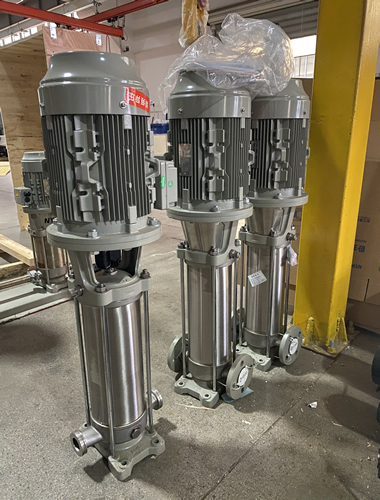Marine centrifugal pump principle is to use the impeller to rotate at a constant speed in the pump casing, so that the liquid in the impeller rotates with the impeller together, and generates centrifugal inertial force, and flies away from the impeller, thereby achieving a kind of suction and discharge of liquid.
Marine centrifugal pumps are widely used on ships, such as cooling pumps for main and auxiliary engines, bilge and ballast pumps, marine fire fighting pumps, marine boiler water feed pumps, general service pumps, etc.

From the structure and operation type, the centrifugal pump and the rotary pump are basically the same, the difference is that the rotor impeller of the centrifugal pump has no metal friction;
From the working principle, the centrifugal pump is completely different from the rotary pump. The suction and discharge of the rotary pump depends on the volume change, while the centrifugal pump relies on the centrifugal force of the liquid in the rotary motion of the impeller, so that the pressure difference between the center of the impeller and the outside of the pump chamber is generated, and then can absorb liquid.
The marine centrifugal pump is mainly composed of impeller, pump casing, pump cover, pump shaft, mechanical seal and other main components. The impeller is mounted on the shaft and rotates with the shaft. The outer edge of the impeller is surrounded by the helical volute cavity on the pump casing. A suction pipe is provided on the pump cover, and a discharge pipe is provided on the pump casing. The impeller is composed of front and rear side plates and curved vanes connected in the middle. A mechanical seal is used to seal between the rotating shaft and the pump casing.
When the marine centrifugal pump is working, the pump casing is filled with liquid first. When the pump shaft drives the impeller to rotate together, the impeller’s vane pushes the liquid in the impeller to rotate together. The liquid generates centrifugal force when it rotates at high speed, and is driven by the impeller center Move to the volute cavity of the pump casing, and the pressure of the liquid in the cavity rises accordingly, and is discharged from the discharge port, and the pressure of the liquid in the center of the impeller decreases to generate a vacuum, which continuously sucks the liquid, so as to achieve the function of transporting the liquid.
During the work of the centrifugal pump, the liquid pressure changes along the radial direction of the impeller: the reason why the pressure of the liquid on the outside of the pump casing rises is that the mechanical energy of the rotation of the impeller is transferred to the liquid and becomes the result of the pressure energy of the liquid. The liquid is thrown to the outer diameter of the impeller under the action of centrifugal force, which forces the amount of liquid in the center of the impeller to decrease, and the pressure drops to form a vacuum, which is lower than the external atmospheric pressure. Under the action of this pressure difference, the liquid is continuously sucked into the center of the impeller. If the pressure on the outer edge of the impeller is greater than the outlet pressure of the pump, the liquid will be continuously discharged from the discharge pipe. If the pressure is equal to the outlet pressure of the pump, the centrifugal pump will run idling without discharging liquid. However, no damage will occur to the pump, which is one of the differences between centrifugal pumps and other positive displacement pumps.
The centrifugal force obtained by the liquid in the centrifugal pump is not only related to the diameter and rotational speed of the impeller, but also related to the density of the liquid. When the density of the liquid is as small as air, the centrifugal force obtained by the rotation of the impeller is too small, forcing the pressure at the center of the impeller to not reach the vacuum, and the liquid whose liquid level is lower than the pump cannot enter the pump under the pressure difference , the pump will not work. This is the main reason why centrifugal pumps do not have dry suction unlike other positive displacement pumps. Therefore, before the centrifugal pump is started, it is necessary to fill the pump chamber with liquid in advance by various methods to remove the gas in the pump and then start the pump to work normally. This process is customarily called the “water diversion” process of the centrifugal pump.

